Validation and Application of Satellite-Derived Sea Surface Temperature Gradients in the Bering Strait and Bering Sea
Abstract
:1. Introduction
2. Material and Methods
2.1. Data
2.1.1. MWIR
2.1.2. CMC
2.1.3. DOISST
2.1.4. OSTIA
2.1.5. Saildrone
2.1.6. NOAA/NSIDC Climate Data Record
2.2. Methodology
- (1)
- Smooth the Saildrone 1 min sampling to the daily time scales of satellite data.
- (2)
- Derive daily SST gradients from the daily Saildrone smoothed product.
- (3)
- Derive SST gradients from the four satellite products based on the finite difference approach.
- (4)
- Collocate satellite-derived SST gradients to the daily smoothed SST gradients along the Saildrone deployment. The method used was a nearest-neighbor approach, where for a given day, the satellite-derived SST pixel closest to the Saildrone daily average for that day was chosen.
- (5)
- The aspatial gradients for all datasets were computed along the Saildrone track.
- (6)
- Linear fits were applied to the time series of the satellite-derived SST gradient maps to examine possible trends.
3. Results
4. Discussion
4.1. SST Gradients and Trends
4.2. Relationship between SST and SIC Gradients
5. Conclusions
Author Contributions
Funding
Data Availability Statement
Acknowledgments
Conflicts of Interest
Appendix A
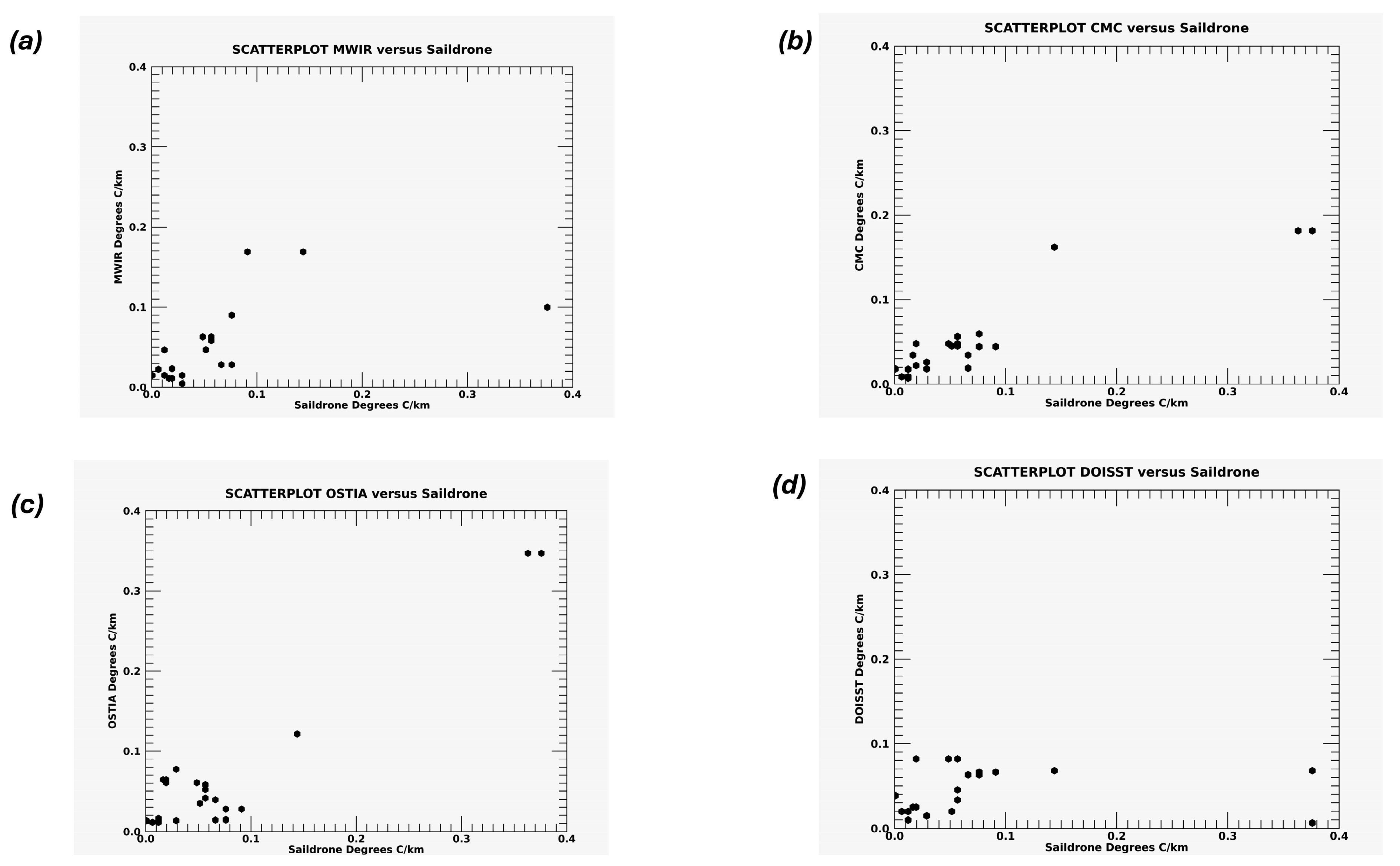
References
- Chin, T.M.; Vazquez-Cuervo, J.; Armstrong, E.M. A multi-scale high-resolution analysis of global sea surface temperature. Remote Sens. Environ. 2017, 200, 154–169. [Google Scholar] [CrossRef]
- Minnett, P.J.; Alvera-Azcárate, A.; Chin, T.M.; Corlett, G.K.; Gentemann, C.L.; Karagali, I.; Li, X.; Marsouin, A.; Marullo, S.; Maturi, E.; et al. Half a century of satellite remote sensing of sea-surface temperature. Remote Sens. Environ. 2019, 233, 111366. [Google Scholar] [CrossRef]
- Hall, S.B.; Subrahmanyam, B.; Steele, M. The Role of the Russian Shelf in Seasonal and Interannual Variability of Arctic Sea Surface Salinity and Freshwater Content. J. Geophys. Res. Oceans 2023, 128, e2022JC019247. [Google Scholar] [CrossRef]
- Zhang, J.; Weijer, W.; Steele, M.; Cheng, W.; Verma, T.; Veneziani, M. Labrador Sea freshening linked to Beaufort Gyre freshwater release. Nat. Commun. 2021, 12, 1229. [Google Scholar] [CrossRef] [PubMed] [PubMed Central]
- Castro, S.L.; Wick, G.A.; Eastwood, S.; Steele, M.A.; Tonboe, R.T. Examining the Consistency of Sea Surface Temperature and Sea Ice Concentration in Arctic Satellite Products. Remote Sens. 2023, 15, 2908. [Google Scholar] [CrossRef]
- Remote Sensing Systems 2017 MWIR Optimum Interpolated SST Data Set Ver. 50; P.O.D.A.A.C.: Pasadena, CA, USA, 2017. [CrossRef]
- Brasnett, B. The impact of satellite retrievals in a global sea-surface-temperature analysis. R. Meteorol. Soc. 2008, 134, 636. [Google Scholar] [CrossRef]
- Banzon, V.; Smith, T.M.; Chin, T.M.; Liu, C.; Hankins, W. A long-term record of blended satellite and in situ sea-surface temperature for climate monitoring, modeling and environmental studies. Earth Syst. Sci. Data 2016, 8, 165–176. [Google Scholar] [CrossRef]
- Donlon, C.J.; Martin, M.; Stark, J.; Roberts-Jones, J.; Fiedler, E.; Wimmer, W. The Operational Sea Surface Temperature and Sea Ice Analysis (OSTIA) system. Remote Sens. Environ. 2012, 116, 140–158. [Google Scholar] [CrossRef]
- Good, S.; Fiedler, E.; Mao, C.; Martin, M.J.; Maycock, A.; Reid, R.; Roberts-Jones, J.; Searle, T.; Waters, J.; While, J.; et al. The Current Configuration of the OSTIA System for Operational Production of Foundation Sea Surface Temperature and Ice Concentration Analyses. Remote Sens. 2020, 12, 720. [Google Scholar] [CrossRef]
- Gentemann, C.L.; Minnett, P.; Steele, M.; Castro, S.; Cornillon, P.; Armstrong, E.; Vazquez, J.; Tsontos, V.; Cokelet, E. 2019 Arctic Saildrone Cruise Report (Version 1); Zenodo: Geneva, Switzerland, 2019. [Google Scholar] [CrossRef]
- Gentemann, C.L.; Scott, J.P.; Mazzini, P.L.F.; Pianca, C.; Akella, S.; Minnett, P.J.; Cornillon, P.; Fox-Kemper, B.; Cetinic, I.; Chin, T.M.; et al. Saildrone: Adaptively sampling the marine environment. Bull. Am. Meteorol. Soc. 2020, 101, 744–762. [Google Scholar] [CrossRef]
- Vazquez-Cuervo, J.; Gentemann, C.; Tang, W.; Carroll, D.; Zhang, H.; Menemenlis, D.; Gomez-Valdes, J.; Bouali, M.; Steele, M. Using Saildrones to Validate Arctic Sea-Surface Salinity from the SMAP Satellite and from Ocean Models. Remote Sens. 2021, 13, 831. [Google Scholar] [CrossRef]
- Meier, W.N.; Fetterer, F.; Windnagel, A.K.; Stewart, J.S. NOAA/NSIDC Climate Data Record of Passive Microwave Sea Ice Concentration, Version 4; National Snow and Ice Data Center: Boulder, CO, USA, 2021. [Google Scholar]
- Vazquez-Cuervo, J.; García-Reyes, M.; Gómez-Valdés, J. Identification of Sea Surface Temperature and Sea Surface Salinity Fronts along the California Coast: Application Using Saildrone and Satellite Derived Products. Remote Sens. 2023, 15, 484. [Google Scholar] [CrossRef]
- Mantua, N.J.; Hare, S.R. The Pacific Decadal Oscillation. J. Oceanogr. 2002, 58, 35–44. [Google Scholar] [CrossRef]
- Sun, C.; Kucharski, F.; Li, J.; Wang, K.; Kang, I.S.; Lian, T.; Liu, T.; Ding, R.; Xie, F. Spring Aleutian Low Weakening and Surface Cooling Trend in Northwest North America During Recent Decades. J. Geophys. Res. -Atmos. 2019, 124, 12078–12092. [Google Scholar] [CrossRef]
- Serreze, M.C.; Barrett, A.P.; Slater, A.G.; Woodgate, R.A.; Aagaard, R.B.; Lammers, R.B.; Steele, M.; Moritz, R.; Meredith, M.; Lee, C.M. The large-scale freshwater cycle of the Arctic. J. Geophys. Res. 2002, 6, 111. [Google Scholar] [CrossRef]
- Xu, G.; Rencurrel, M.C.; Chang, P.; Liu, X.; Danabasoglu, G.; Yeager, S.G.; Steele, M.; Weijer, W.; Li, Y.; Rosenbloom, N.; et al. High-resolution modelling identifies the Bering Strait’s role in amplified Arctic warming. Nat. Clim. Change 2024, 14, 615. [Google Scholar] [CrossRef]
- Dai, A.; Luo, D.; Song, M.; Liu, J. Arctic amplification is caused by sea-ice loss under increasing CO2. Nat. Commun. 2019, 10, 121. [Google Scholar] [CrossRef]

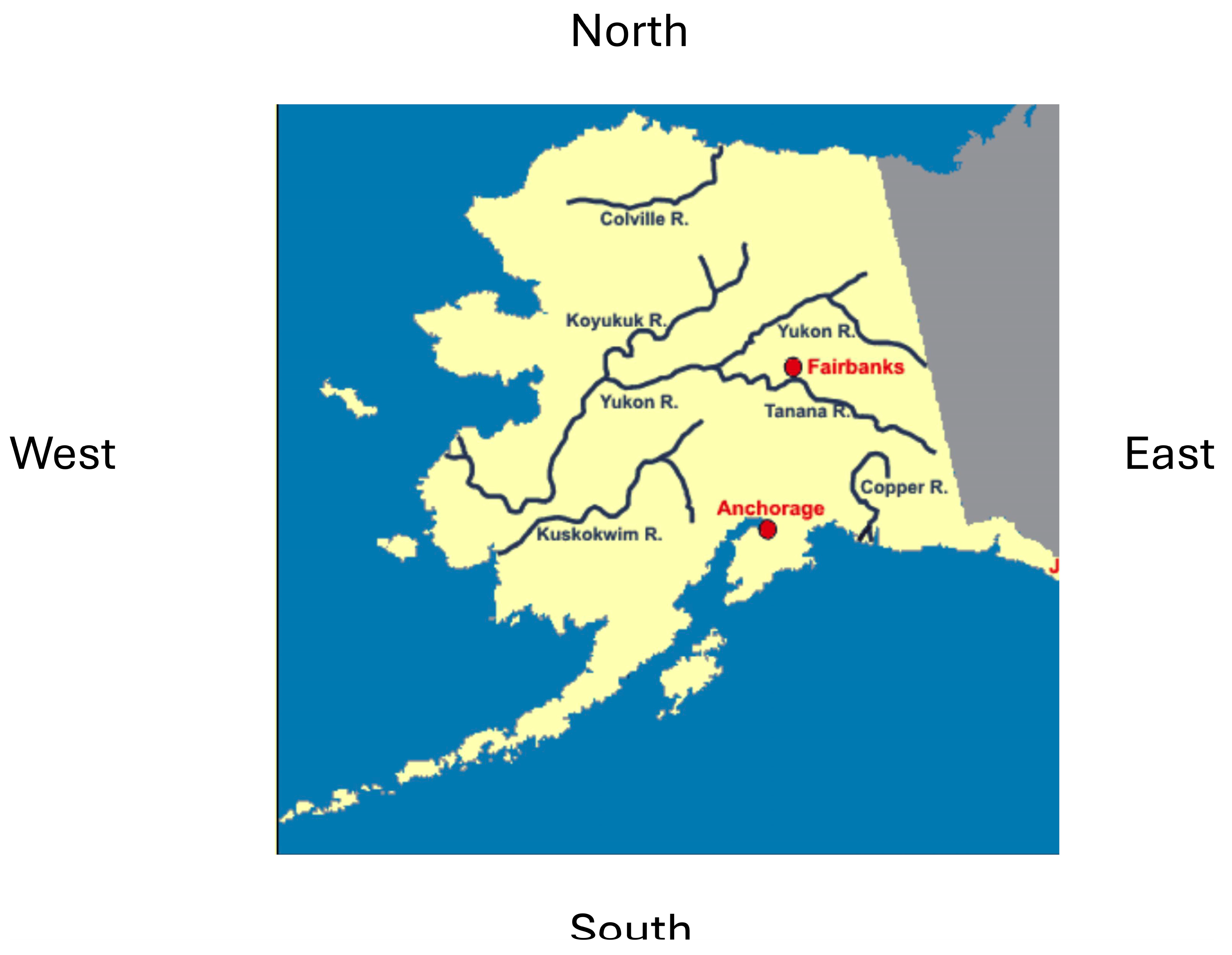
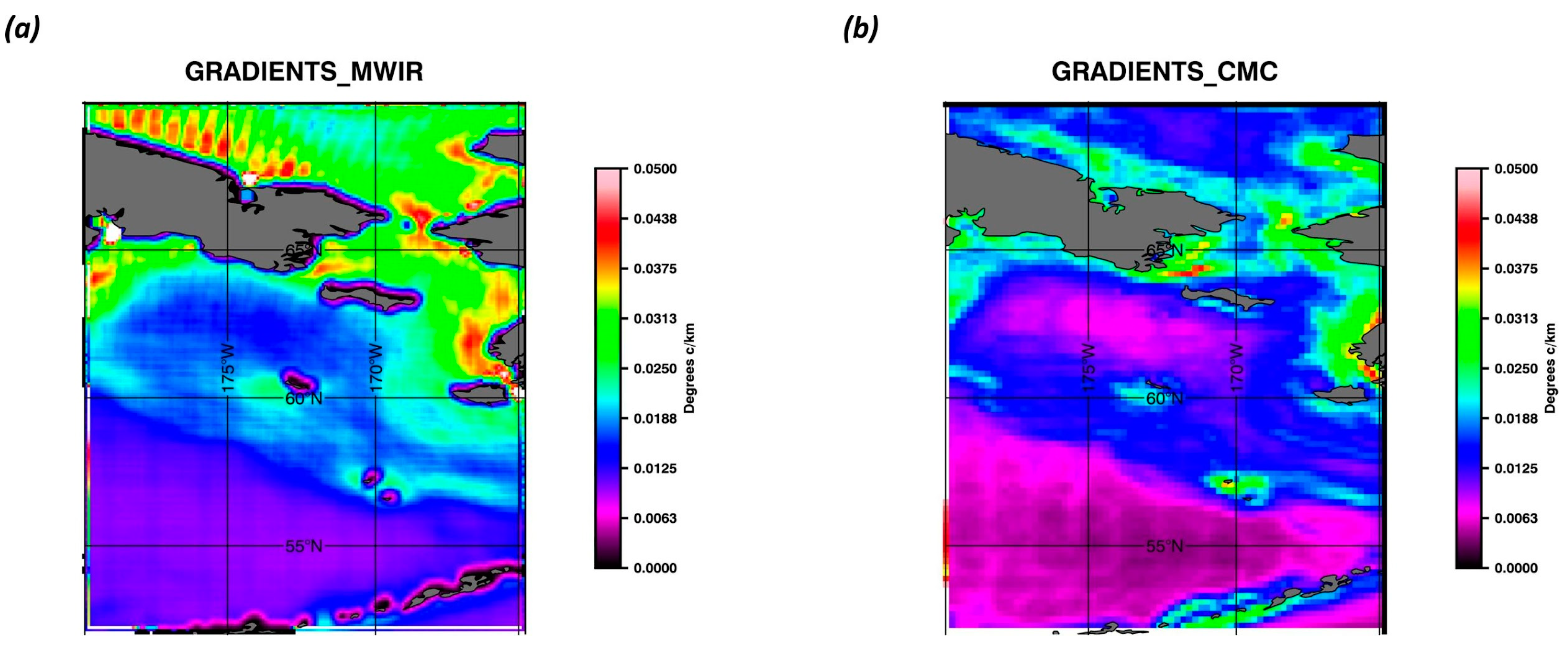
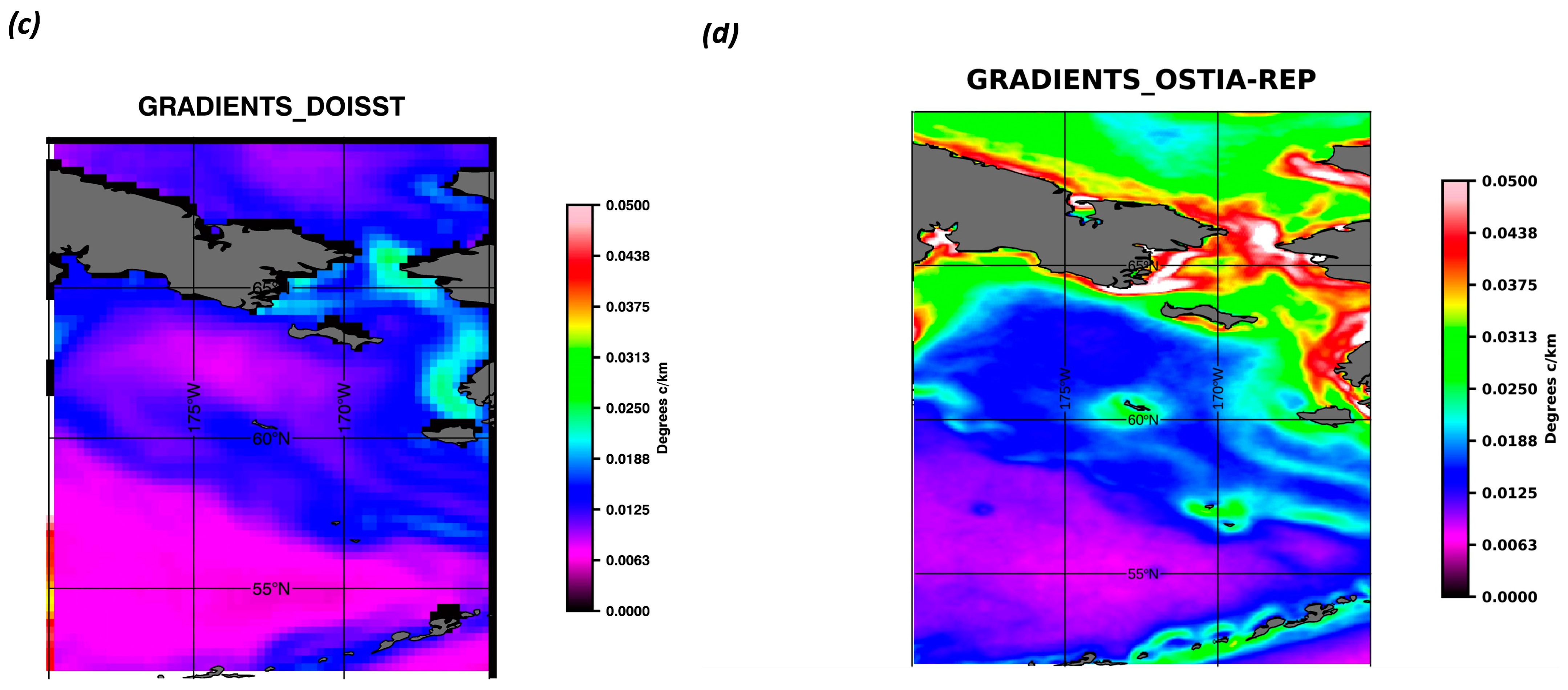
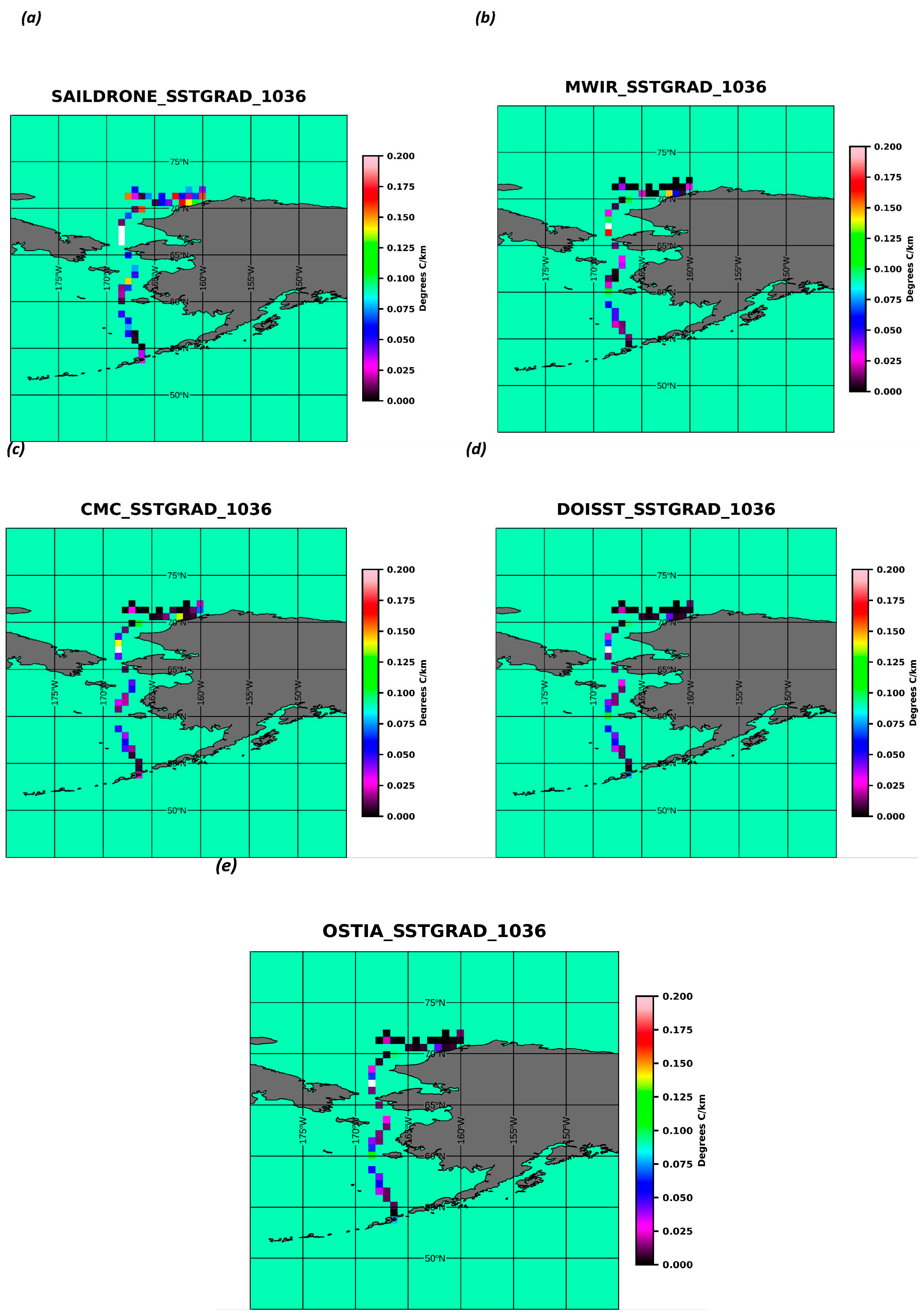
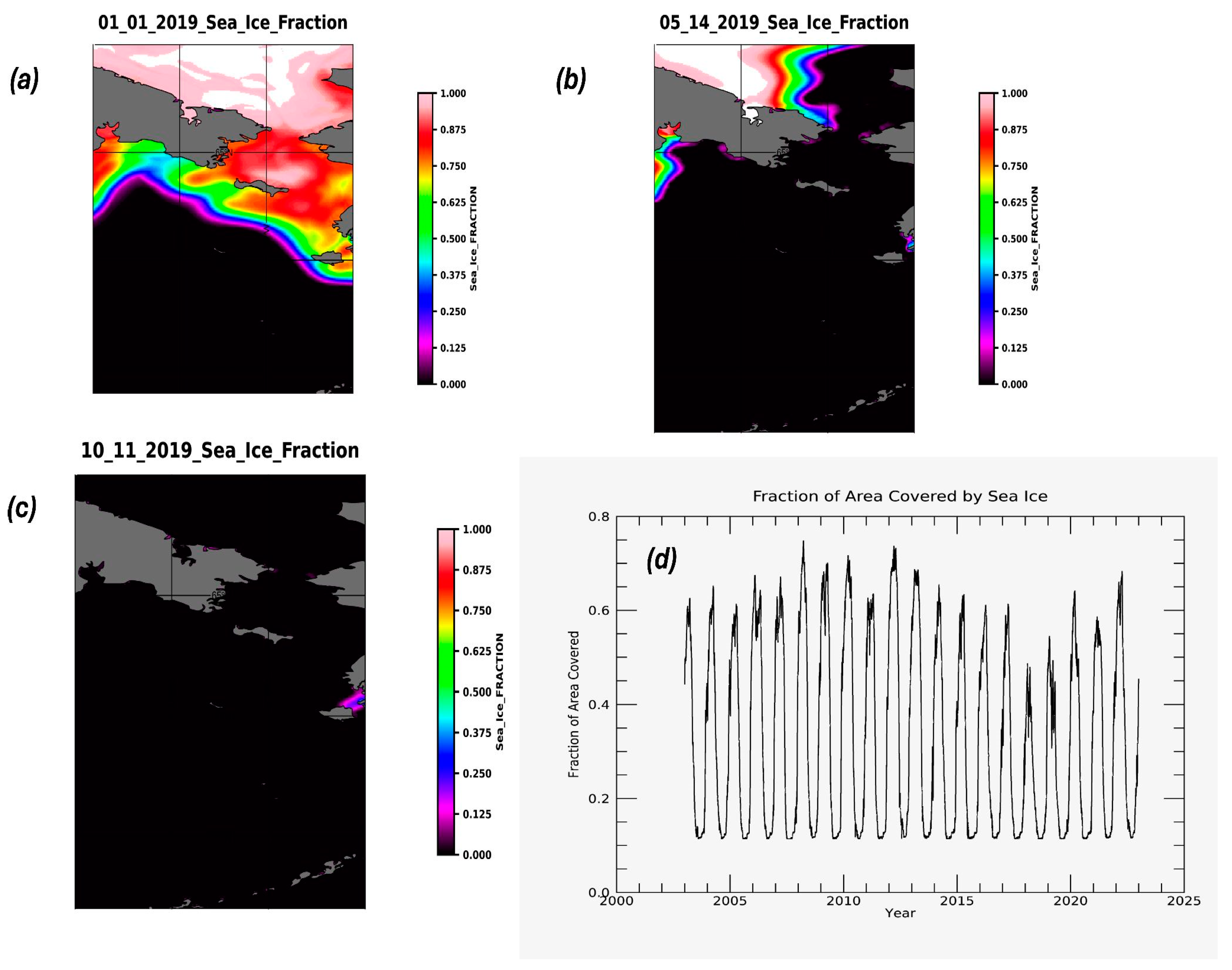
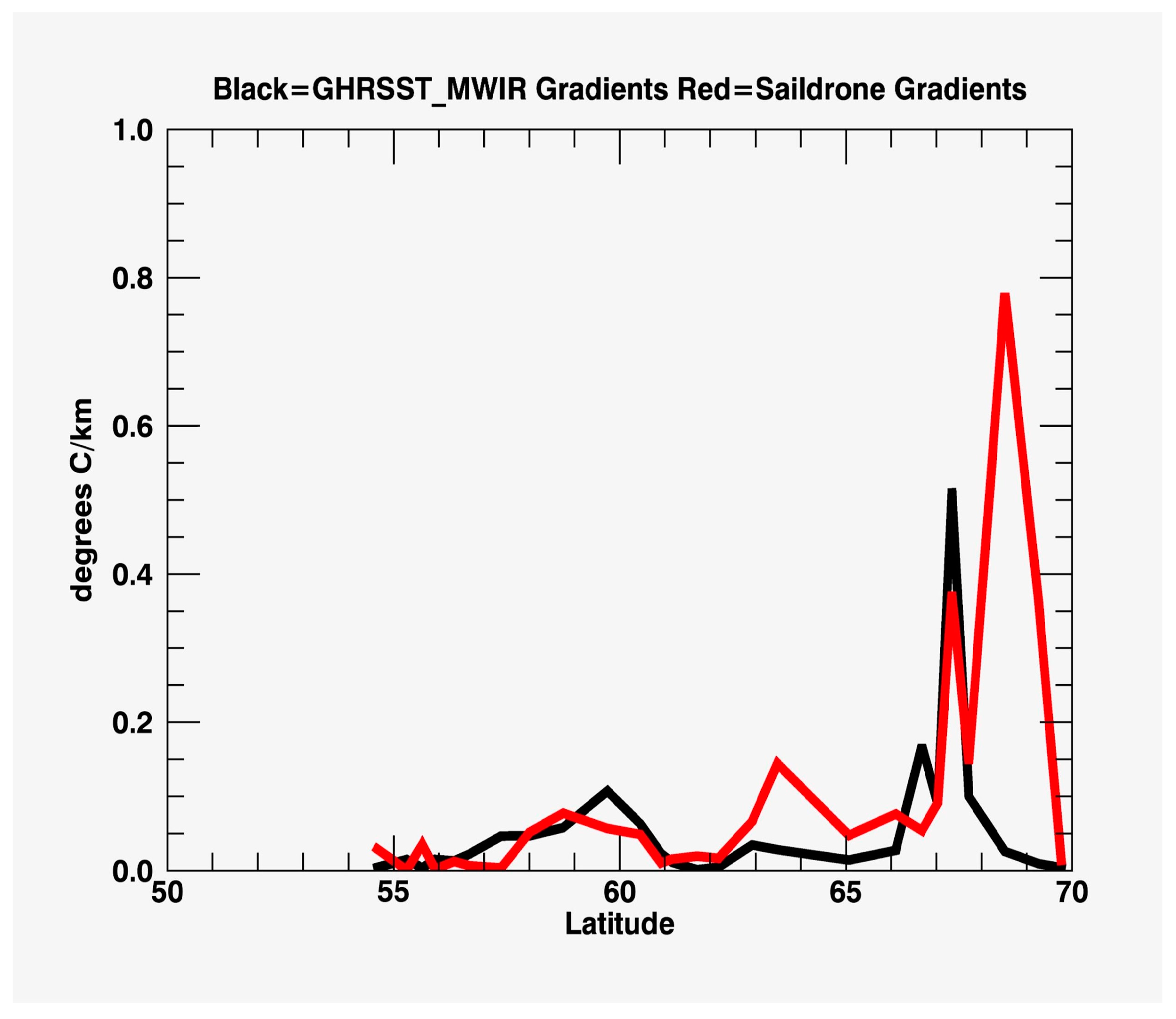




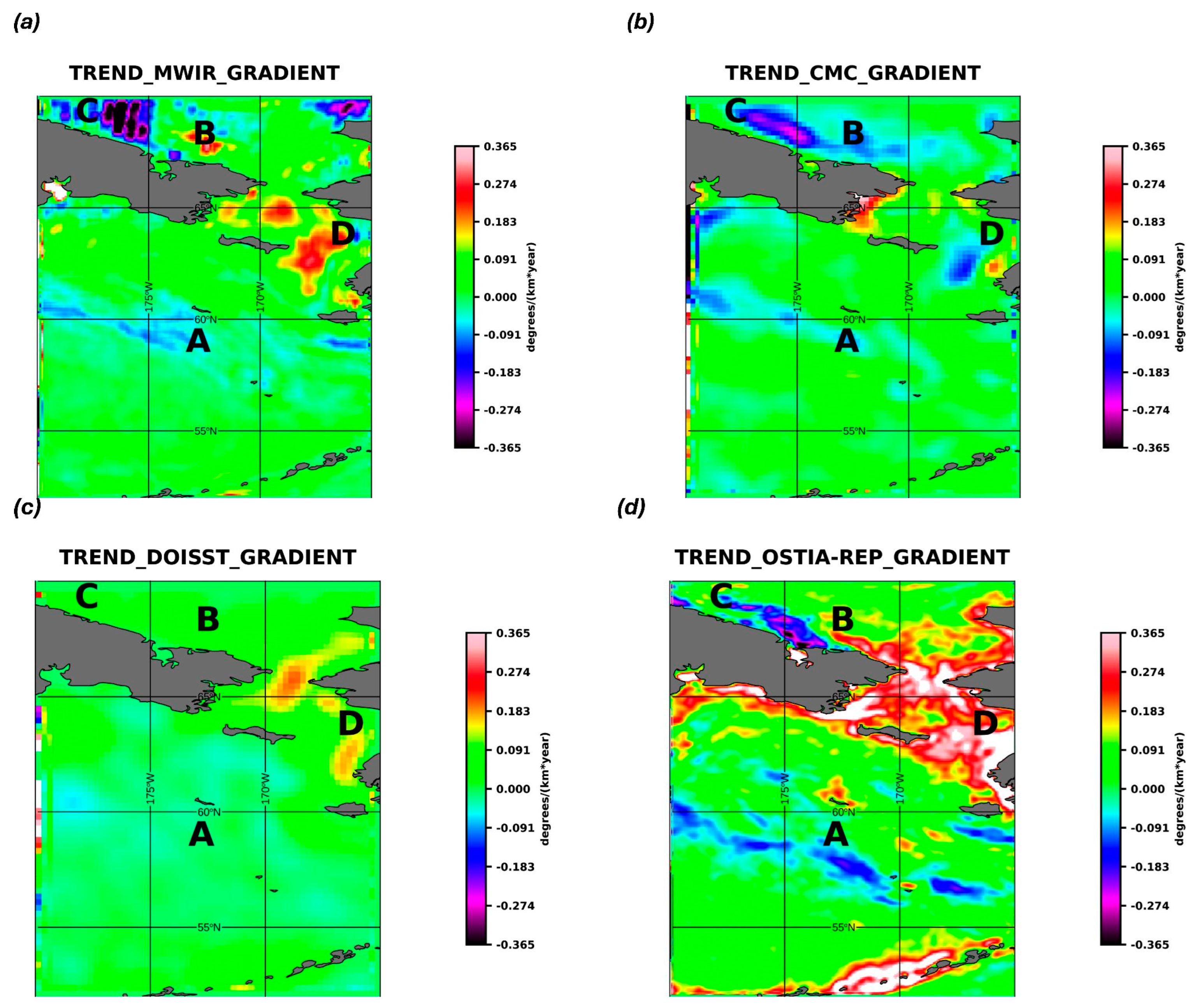





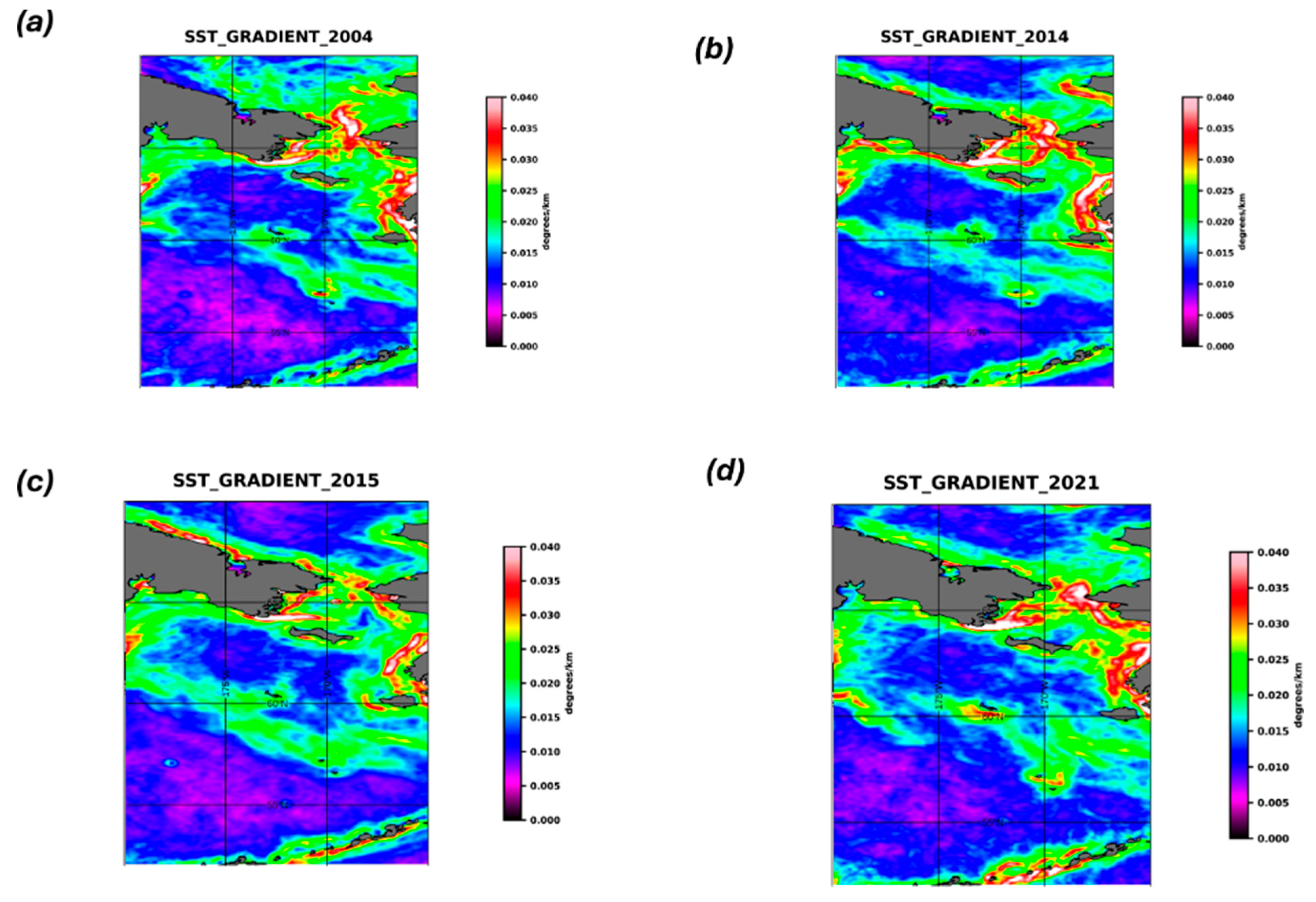

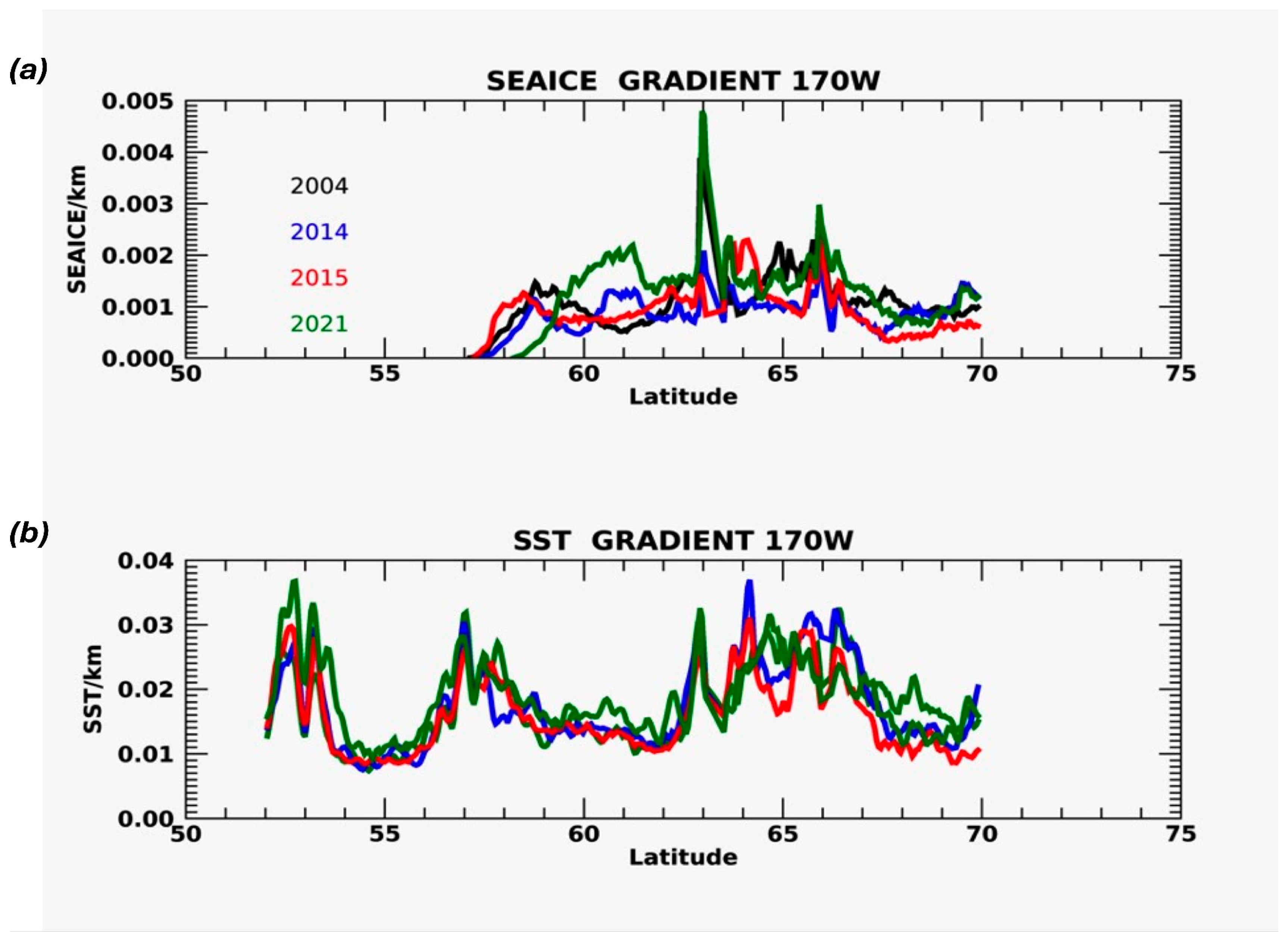

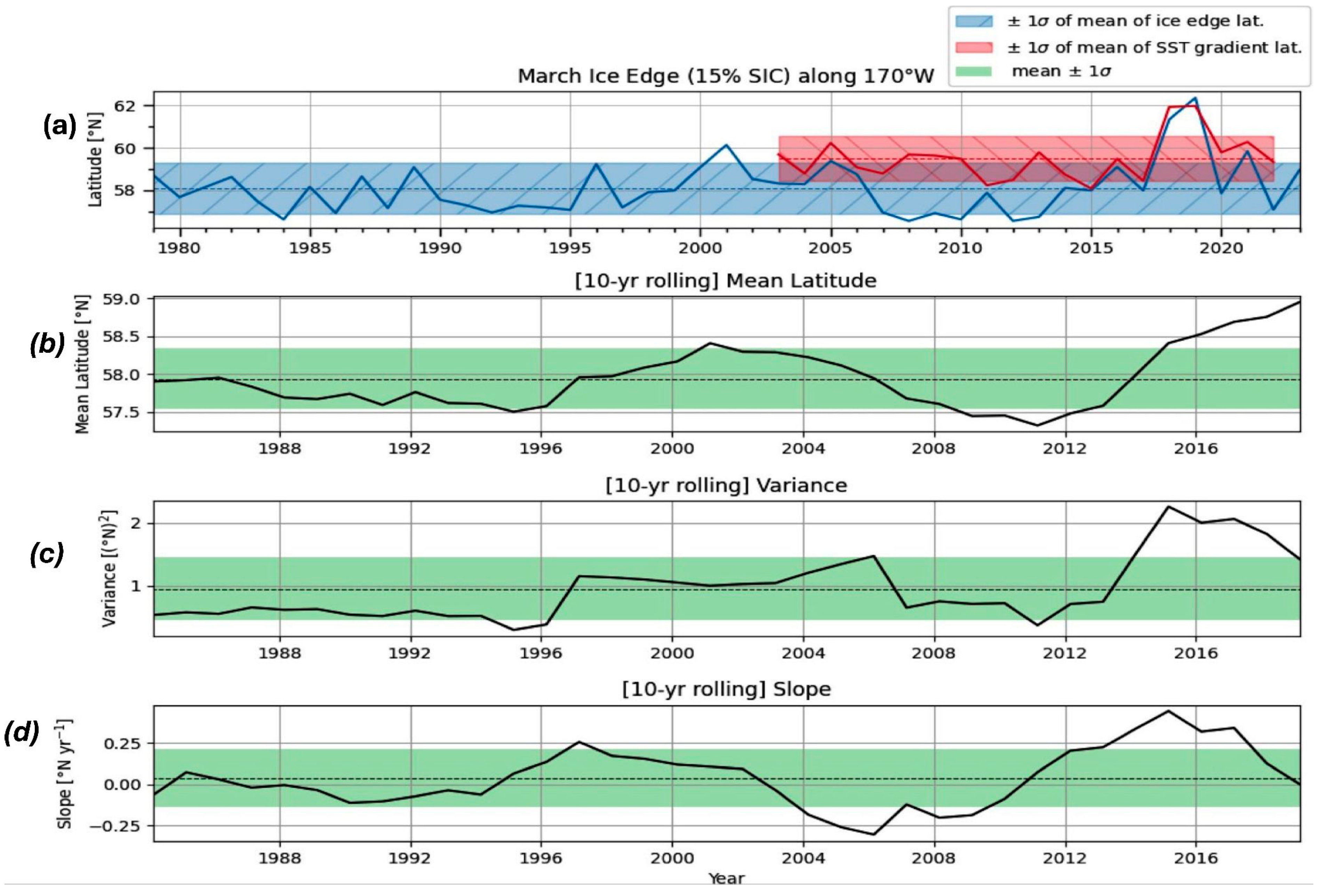
| Dataset | Correlation | Bias °C/km | RMSD °C/km | STD Satellite °C/km | STD Saildrone °C/km | Signal to Noise |
|---|---|---|---|---|---|---|
| MWIR | 0.31 | −0.04 | 0.16 | 0.10 | 0.19 | 1.17 |
| CMC | 0.81 | −0.04 | 0.11 | 0.08 | 0.19 | 1.72 |
| DOISST | −0.11 | −0.06 | 0.17 | 0.04 | 0.19 | 1.11 |
| OSTIA | 0.79 | −0.01 | 0.11 | 0.17 | 0.19 | 1.76 |
| Product | Source |
|---|---|
| MWIR | sea ice fraction (sea ice concentration) source = “EUMETSAT OSI-SAF” |
| CMC | sea ice fraction source = “DMSP-F15 DMSP-F17 DMSP-F18 Metop-1 Metop-2 Metop-3 G COM-W1” |
| DOISST | sea ice fraction source = “MMAB_50KM-NCEP-ICE” |
| OSTIA | sea ice fraction source = “EUMETSAT OSI-SAF” |
| YEAR | CORRELATION | MEAN SIC Gradients (SIC/KM) | MEAN SST Gradients (Degrees C/KM) | RMS SIC Gradients SIC/KM) | RMS SST Gradients (Degrees C/KM) |
|---|---|---|---|---|---|
| 2004 | 0.96 | 0.0008 | 0.0175 | 0.0008 | 0.006 |
| 2014 | 0.94 | 0.0006 | 0.0173 | 0.0004 | 0.006 |
| 2015 | 0.95 | 0.0006 | 0.0159 | 0.0005 | 0.005 |
| 2021 | 0.96 | 0.0008 | 0.0185 | 0.0008 | 0.005 |
Disclaimer/Publisher’s Note: The statements, opinions and data contained in all publications are solely those of the individual author(s) and contributor(s) and not of MDPI and/or the editor(s). MDPI and/or the editor(s) disclaim responsibility for any injury to people or property resulting from any ideas, methods, instructions or products referred to in the content. |
© 2024 by the authors. Licensee MDPI, Basel, Switzerland. This article is an open access article distributed under the terms and conditions of the Creative Commons Attribution (CC BY) license (https://creativecommons.org/licenses/by/4.0/).
Share and Cite
Vazquez-Cuervo, J.; Steele, M.; Wethey, D.S.; Gómez-Valdés, J.; García-Reyes, M.; Spratt, R.; Wang, Y. Validation and Application of Satellite-Derived Sea Surface Temperature Gradients in the Bering Strait and Bering Sea. Remote Sens. 2024, 16, 2530. https://doi.org/10.3390/rs16142530
Vazquez-Cuervo J, Steele M, Wethey DS, Gómez-Valdés J, García-Reyes M, Spratt R, Wang Y. Validation and Application of Satellite-Derived Sea Surface Temperature Gradients in the Bering Strait and Bering Sea. Remote Sensing. 2024; 16(14):2530. https://doi.org/10.3390/rs16142530
Chicago/Turabian StyleVazquez-Cuervo, Jorge, Michael Steele, David S. Wethey, José Gómez-Valdés, Marisol García-Reyes, Rachel Spratt, and Yang Wang. 2024. "Validation and Application of Satellite-Derived Sea Surface Temperature Gradients in the Bering Strait and Bering Sea" Remote Sensing 16, no. 14: 2530. https://doi.org/10.3390/rs16142530






